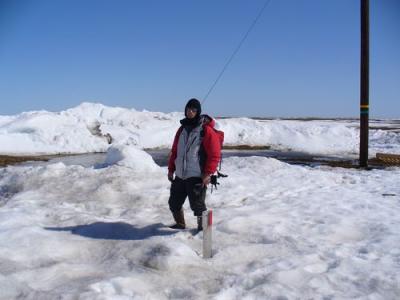Jack’s weather report: 11:25 p.m. Barrow time
Temperature: 35 °F
Wind Speed: 13- 14 knots (15 -17 mph)
Wind Chill: 18 °F
The changes that have occurred on the tundra in the week I have been here are phenomenal. When I arrived May 31st the ground out at our research site was completely covered with snow, but the melt has been fast and dramatic. The pictures below show the difference in the snow cover over the past week. The first photo, taken June 3rd, shows the boardwalk and tramline, while the second photo was taken on June 8th.

Tram Line at the Biocomplexity Site (taken June 3rd)
 Dike Separating Two of the Experimental Areas Within the Biocomplexity Site
Dike Separating Two of the Experimental Areas Within the Biocomplexity Site
(photo taken June 8th)
Of course with all the melt the water has to go somewhere. The tundra is relatively flat and the permafrost, permanently frozen ground, does not allow for the water to percolate into the soil. So, where does the water go? Where would you go if you were water? It flows to the lowest spot it can find. This creates ponds and thaw lakes. The pictures below give you an indication of the volume of water that is flowing.

This is a Fast Flowing Current of Water (taken June 8th)
Remember, what has melted in the past week is snow that has accumulated over the winter. There is a lot of water stored in the snow and our weather the past week has really accelerated the snow melt. It’s not that the temperatures have been high, they have stayed in the upper 30’s to 40’s during maximum sunlight, it’s the wind that is causing the acceleration. Even the sea ice is melting, but only at the surface. Supposedly it is still plenty thick…..hmmm….does it look safe to you?

Sea Ice Melting (taken June 9th)
Finally, with the wind whipping, this is how you dress.

Just Making it to the Biocomplexity Site

